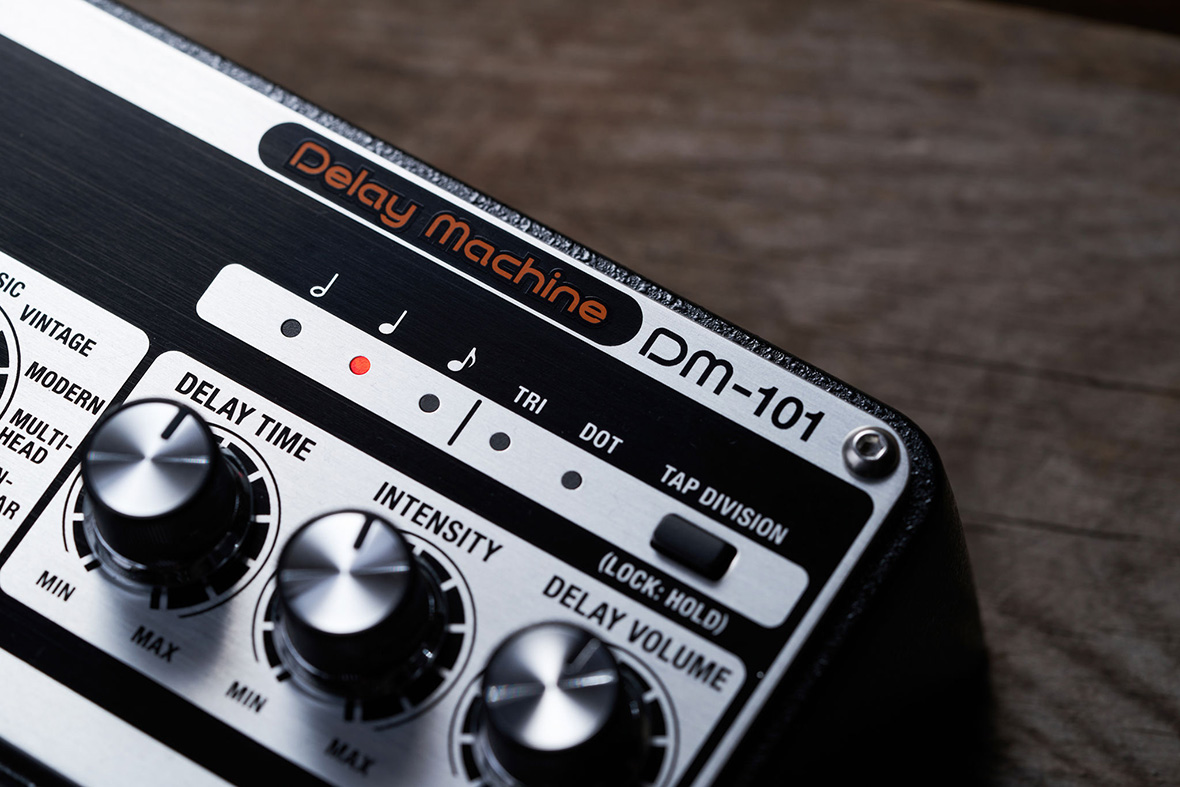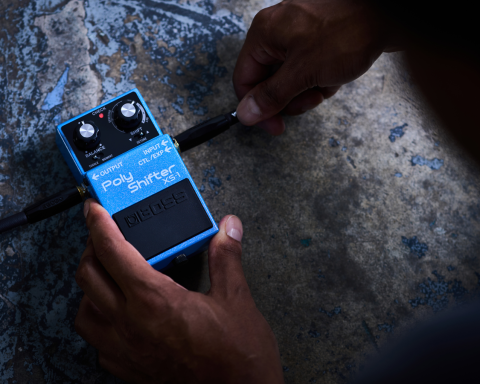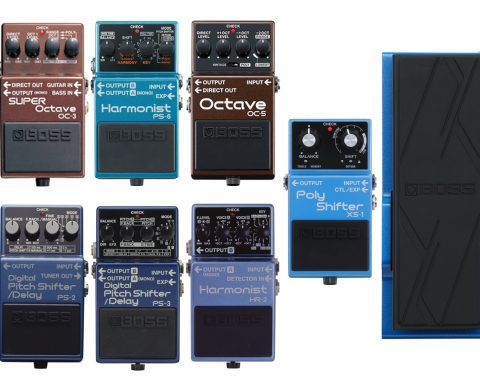The world of delay pedals is expansive, full of incredible sounds and features. This guide will help navigate the array of delay sounds, standard functionality, and the differences between each type. We’ll dive into the world of delay pedals, answer questions, and provide insights into the different delays available. Let’s explore the need for delay pedals, when to use them, and examine a selection of units.
What is a Delay Pedal?
In short, a delay pedal records a guitar or bass signal and plays it back. Delay signals get measured in milliseconds, so it takes a quick millisecond “snippet” of the sound and repeats it.
A delay pedal is essential for guitarists and bass players of all levels. Delay can make guitar lines thicker, fill the dead space, or work as an instrument in its own right. Think U2’s “Where the Streets Have No Name,” Pink Floyd’s “Echoes,” or any Rage Against the Machine or Audioslave solo. Tom Morello fills in the gaps between guitar lead lines and uses the delay as a percussive instrument.
What Does a Delay Pedal Do?
In the most basic terms, a delay pedal takes the signal, records it, usually measured in milliseconds, and plays it back to you several times. The scientific explanation is that delay duplicates the signal and plays back the copy after a time interval in milliseconds. Delay pedals generate an echo effect that can go from slapback, instant repeat, to drawn-out repeats.
When a guitarist plays between the repeats, the delay pedal stores that signal and then plays it back, creating an overlapping effect. The result can be as simple as a single echo or as complex as a cascading waterfall of sound that slowly oscillates into itself, creating a wall of sound. Think of the “Karma Police” outro by Radiohead.
"When a guitarist plays between the repeats, the delay pedal stores that signal and then plays it back, creating an overlapping effect."
How is Delay Different than Looping?
Delay pedals take a millisecond snippet of the guitar signal and repeat it back. Loop pedals take any number of seconds or minutes, record it, and then play it back. The most significant benefit of looper compared to delay is the ability to control play, overdub, and stop freely and to repeat the recorded sounds without a decrease in level or sound change.
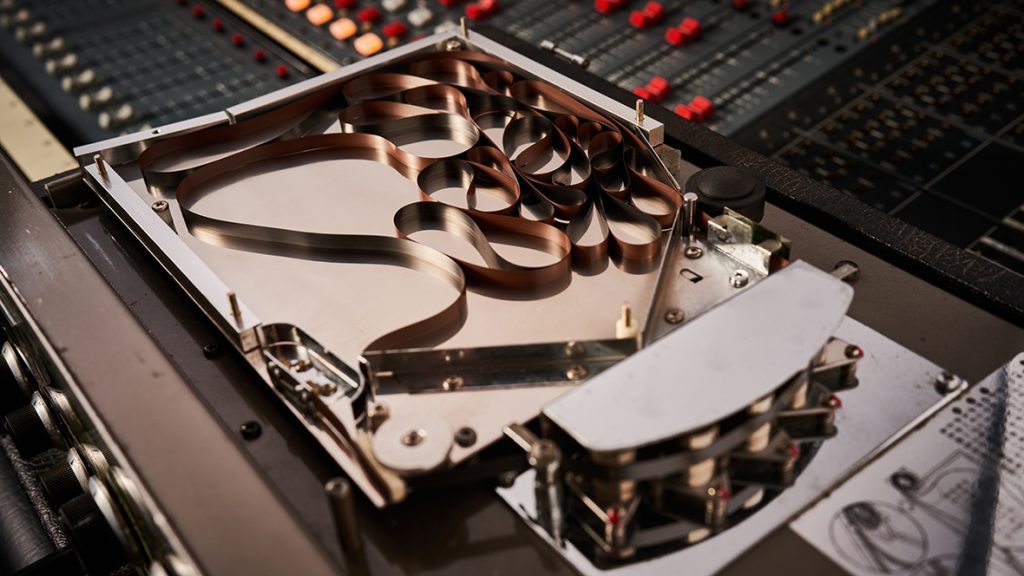
Delay Types
Technically, there are three main types of delay: tape, analog, and digital. Within these types, there are many styles. For example, analog delay often includes echo and tape delay. Digital delay includes dynamic delay, pattern delay, and other types. Key differences lie in how many repeats they provide and whether they repeat linearly or have trails and degradation. Let’s explore these three delay types.
Tape Delay
Tape delay, sometimes called tape echo delay, once used magnetic tape to record and playback the signal. This style has warm, slightly unpredictable repeats. The sound gradually degrades as the delay continues, reflecting the age of the tape.
Tape degradation or flutter is a feature that has been beautifully replicated for the RE-202 and RE-2 pedals. The benefit of a tape delay is that one gets somewhat unpredictable results and subtle differences in the repeats each time. This is what vintage-style delay pedal lovers appreciate.
"A mono setup is straightforward, while a stereo delay setup can offer a more surreal, immersive, expansive sonic experience."
Analog Delay
Analog delays, or Bucket Brigade delays, like the DM-2W and the DM-101, use Bucket Brigade Devices (BBDs) to create warm repeats. They provide a near-perfect replication of a signal slightly degrading over time. The benefit of an analog delay is that one gets a warm, rich delay sound with more predictable and re-creatable results.

For analog delay, many players consider DM-101 the ultimate. This pedal includes:
- Classic—Warm analog delay sound extended with up to 1200 ms of delay time
- Vintage—Retro analog delay inspired by the iconic DM-2 Delay pedal introduced in 1981
- Modern—Clear analog delay with a distinctive high-end tone and up to 840 ms delay time
- Multi-Head—Emulates a multi-head tape delay with analog BBD sound character
- Non-Linear—Produces consecutive short delays (35–190 ms) that gradually increase in volume
- Ambience—Simulates a small space
- Reflect—A stereo delay sound that produces a reverb-style effect
- Doubling and Delay—A stereo effect that combines a doubled sound with a longer delay
- Wide—Stereo delay with offset left/right delay times for an expansive sound
- Dual Mod—A stereo delay with different modulation phase settings on the left and right outputs
- Pan—A tapped stereo delay with varying delay times distributed across the sound field
- Pattern—Stereo delay with different rhythmic patterns
Digital Delay
Digital delays, such as the DD-200, offer a more precise, pristine signal repeat that does not degrade in quality. Digital delays often come with various modes to recreate different styles of delay. These include replications of analog and tape delays.
The key benefit of a digital delay is precise, pristine repeats without degradation. There is also the option to create ducking effects and dynamic delays. Here, one can set delays to repeat at different intervals or even recreate the sound of a tape delay without needing actual magnetic tape.

There are other delay styles, too, such as those featured in the BOSS DD-200:
- Standard—Clear digital delay
- Analog—Emulates classic analog “BBD” delays like the BOSS DM series
- Tape—Emulates the warm sound of the legendary RE-201 Space Echo
- Drum—Models the drum-based Binson Echorec 2
- Shimmer—Pitch-shifted delay for lush, heavenly textures
- Tera Echo—Spacious ambience effect derived from the TE-2
- Pad Echo—Newly developed sound for drifting ambient textures
- Pattern—Rhythmic sounds with 16 delay lines layered together
- Lo-Fi—Delay sound with fat, distorted character
- Dual—Two different delay lines connected in series
- Reverse—Backwards delay for cool psychedelic effects and other unique tones
- Ducking—Delay with a built-in ducking effect
Using a Delay Pedal
A delay pedal adds thickness to solos, creates riffs that repeat, adds ambience, or creates lead lines that have a doubling effect. When it comes to playing music, there are no rules. With that in mind, there are no hard and fast rules for when to use a delay pedal. It depends on the type of sound you want and the music you’re trying to create.
For an easy-to-use bucket brigade delay, the BOSS DM-2W pedal is your perfect analog delay pedal. Modeled on one of the most incredible delay pedals of all time, the DM-2, the DM-2W provides two circuits. The original delay circuit with 20-300 ms delay time, and the new Waza Craft setting, with a warm, clear delay sound with a maximum 800 ms delay time
"When it comes to playing music, there are no rules. With that in mind, there are no hard and fast rules for when to use a delay pedal."
The DM-101 boasts 12 analog delay effects powered by BBD circuitry. These range from subtle delays to Pink Floyd-esque soundscapes. It’s the analog delay pedal fan’s ultimate dream rig, providing an analog sound with digital reliability and modern connectivity.
All guitarists will appreciate the simplicity of the DD-8. The pedal provides a range of digital, tape, and analog delay sounds packed in an intuitive stompbox. Easy to manipulate, it provides enough functionality for all levels and sits beautifully on a pedalboard.
Looking for a digital delay pedal with studio-quality audio conversion and access to a range of digital delays? Try the DD-200 or DD-500. There are 12 modes to choose from, including digital and analog-inspired delays. Plus, there is class-leading sound quality with 32-bit AD/DA, 32-bit floating point processing, and 96 kHz sampling rate. The pedal includes a 60-second phrase looper and MIDI connectivity.
"Tape echo is unique. It has quirks, idiosyncrasies, and a recognizable sound."
Tape echo is unique. It has quirks, idiosyncrasies, and a recognizable sound. Fortunately, the Roland Space Echo, one of the most respected delay units ever, lives on in the RE-2 Space Echo. This pedal fits on a pedalboard, providing tape flutters and the unpredictable sonic qualities we love.
BOSS DELAY HISTORY
Roland released the RE-201 Space Echo in 1974. It is widely regarded as the best tape-based delay unit ever made. The effect lives on in pedalboard-friendly versions of the RE-20, the RE-202, and the RE-2.
Flash forward to 1978. When guitarists couldn’t afford expensive rack units or carry them around, BOSS released the DM-1 Delay Machine. It was one of the world’s first pedalboard-friendly delay units. The legacy lives on with the DM-101. In 1981, BOSS released the DM-2 delay that shrunk the abilities of the DM-1 into that smaller format, making it a lot easier to add to pedalboards and rigs. For the DM-2, BOSS employed a bucket-brigade device (BBD) instead of the CDD used in the DM-1, spawning the Bucket Brigade stompbox world.
In 1983, rack units like the SDE-3000 Digital Delay were at the forefront of music tech. They became vital components in guitar effects systems for Steve Vai and Eddie Van Halen. The BOSS DD series has been the go-to for countless guitarists since it debuted in 1983. The DD-2, the world’s first digital delay pedal, was a game-changer for guitarists. It offered longer delay times and greater sound quality and control. BOSS continues to innovate, adding features like tap tempo, multiple delay modes, and options for stereo setups.
"The DD-2, the world’s first digital delay pedal, was a game-changer for guitarists. It offered longer delay times and greater sound quality and control."
Analog vs. Digital Delay
When choosing between analog and digital delay, consider the desired sound. Is it a slowly degrading signal with incremental change or a degrading volume signal with perfect repeats? Want it to sound weirder or warmer the more repeats happen, or the same forever?
The difference between digital and analog delay comes down to the gradual change in sound quality. Eventually, an analog sound will slightly degrade. This creates a slow shift in sound, whereas a digital delay repeats the same sound, only getting quieter each time.

Analog delay pedals like the BOSS DM-2 produce warm, dark, and slightly degraded repeats, which many players find pleasing to the ear. On the other hand, digital delay pedals like the BOSS DD-200 provide cleaner, more precise repeats. They often come with various modes and settings for a wide range of delay effects. While an analog delay might be ideal for classic rock, a digital delay could be the right choice for metal, fusion, experimental, or other modern genres.
Differences Between Delay, Reverb, and Tape Echo
Delay records the input signal and delays it for a specified time. Then it plays it back for a natural repeated effect that degrades slightly each time. This creates a sense of ambiance or spatial depth and often includes settings like plate, spring, and hall.
"Delay records the input signal and delays it for a specified time. Then it plays it back for a natural repeated effect that degrades slightly each time."
Tape echos degrade in sound quickly, providing a warmer delay style than a standard delay pedal. Unlike reverb, which creates the sound of playing in a large room or hall, the delay provides a clear, repeated echo of the original signal. The echoes can get manipulated in many ways to create various effects. One can elongate the number of repeats and extend the space between them.
SETUP CONSIDERATIONS
Connecting a Delay Pedal
One can connect a delay pedal directly through a pedalboard at the end of the signal chain or in the effects loop. Let’s look at mono vs. stereo, FX loops, signal chains, wet/dry setups, and series vs. parallel delay.
Delay in the Signal Chain
Delay pedals get placed at the end of the signal chain. This way, they will not affect any other pedals in the chain. However, they will repeat the combined sounds of the guitar and all the pedals placed before them. If one puts them at the start, it delays the signal reaching the pedal afterward. This will reduce the effectiveness of both pedals.
Placing delay pedals at the end of the chain allows the delay to create a spacious and natural echo effect that uses all the effects before it. However, as always, there’s no strict rule when it comes to music. Experimenting with different placements can lead to unique results.
"Placing delay pedals at the end of the chain allows the delay to create a spacious and natural echo effect that uses all the effects before it."
FX Loop
An effects loop is an input/output that allows players to insert effects between the preamp and the power amp. These are where the amp gets its tone and volume, respectively.
An FX loop improves the interaction between the amp and effect pedals by not letting the amp affect the pedal’s sound. Placing a delay pedal in the FX loop can produce a clearer, cleaner delay effect. This is especially true using a distorted amp sound as one bypasses the preamp. The pedal won’t get affected by the amp. This is especially useful for digital delay pedal players, who probably want the cleanest signal possible.

Mono vs. Stereo Delay
Thinking of headphone listening when discussing mono and stereo delay is useful. A mono delay is a single repeat of the original signal and works perfectly in most situations with a guitar solo or lead line. Most analog delays are mono. Stereo delay, on the other hand, provides two delay signals, one for the left and one for the right headphone or speaker. This creates a broad, enveloping sound field that one can manipulate for different timed delays in each speaker/earphone.
A mono setup is straightforward, while a stereo delay setup can offer a more surreal, immersive, and expansive sonic experience. This is particularly true when playing in large rooms with two amplifiers/cabinets or headphones. Dynamic delays use stereo delay to great effect. For example, one could have a left headphone/speaker delaying at 12ms and your right headphone /speaker delaying at 800. This creates the illusion of two different guitarists playing at different times.
"A mono setup is straightforward, while a stereo delay setup can offer a more surreal, immersive, and expansive sonic experience."
Wet/Dry
Delay pedal users, primarily those who use dual amplifiers and those who want to retain a good chunk of their original signal, will use a wet/dry setup. The wet signal is the one with the effect on the pedal. The dry signal is just the guitar.
In a wet/dry setup, one amplifier (or speaker) plays the dry, unaffected guitar signal while the other plays the wet, effects-loaded signal. Guitarists can retain a dry signal and have the wet signal as a subtle addition to the tone. A perfect example is “Love Is Only A Feeling” by The Darkness. The main riff has a predominantly dry signal with a slight delay in the background. The solo line over the top has a wet signal, a heavier delay.
The benefit of using dual amplifiers with delay, with one wet and one dry, is that it can provide a greater sense of depth and space. The dry signal maintains the original tone and articulation without becoming muddy. At the same time, the wet signal provides the ambient, echo effects from the delay. It’s the best of both worlds.
A wet/dry setup with dual amplifiers can be particularly effective when using high levels of delay or other time-based effects. It prevents the original signal from getting washed out. However, one can also use the wet/dry setting on the effects pedal to dial back the delay’s volume while retaining the original signal.
"The benefit of using dual amplifiers with delay, with one wet and one dry, is that it can provide a greater sense of depth and space."
Series vs. Parallel Delay
A series delay is a signal chain that goes right to left or left to right. And the signal passes through every pedal affected by the first sound. Parallel systems would go into two outputs, into separate effects, and then we mix them. In this case, neither effect gets affected by the other.
When using two delay pedals in a series setup, one delay pedal feeds into the next, each applying its delay effect on top of everything that’s come before. This creates an intricate yet potentially washy sound.
Using Parallel Delay
In a parallel setup, each delay pedal processes the original signal independently, and its outputs get mixed afterward. A parallel setup like this can separate multiple delays and prevent them from getting washed out.
Pedals like the DD-8, when running in stereo mode, provide linked parallel delays on the left and right channels. This allows one to maintain the true balance of stereo input sources in the effect sound. The SDE-3000D Dual Digital Delay allows players to run two delays in series or parallel, which is very useful if you appreciate both sounds.
Delay Pedal Controls
The most common controls on a BOSS delay pedal are effect level, feedback, time, mode, tap tempo, and hold. In short, effect level is the volume of the effect, feedback is the number of repeats, time is the time between delays, and mode is the type of delay. Tap tempo is when players tap the pedal at the beat of the music or time signature. Hold allows one to hold the pedal down, which repeats to self-oscillation.
Effect Level
The effect level control determines how loud the delayed signal is compared to the original signal. Turning this knob up will increase the volume of the delayed notes or the wet signal. Turning it down will make them quieter, increasing the dry signal.
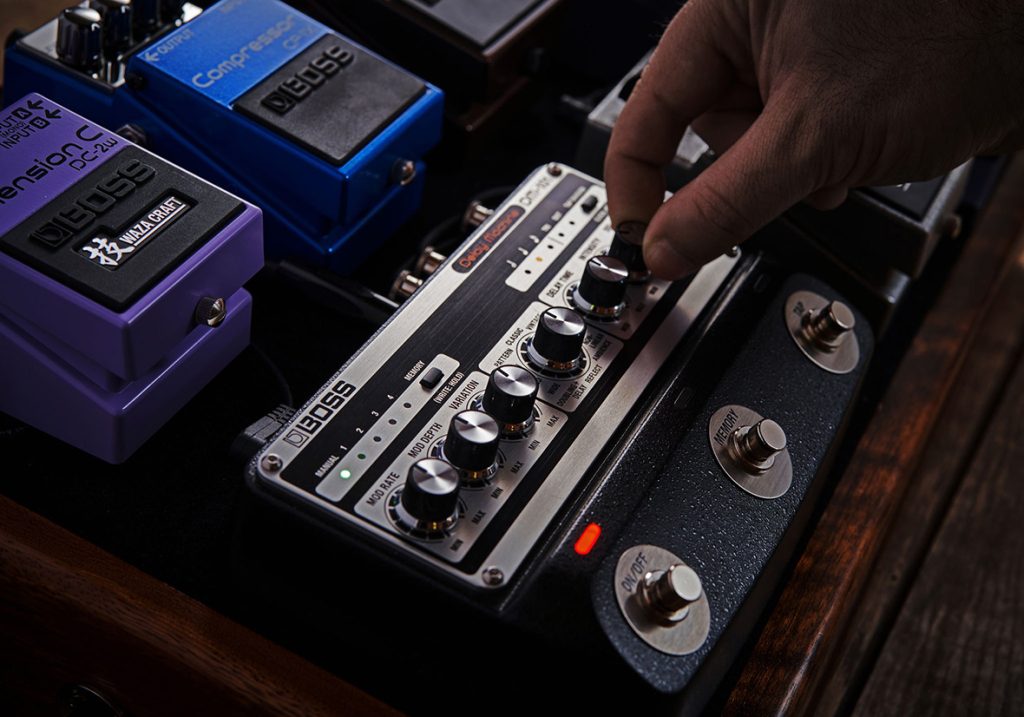
Feedback
Feedback on a delay pedal controls how many times the delayed signal gets repeated. Turning the feedback down will result in fewer repeats. High feedback settings can create a near-infinite series of repeats, leading to self-oscillation. In this dramatic effect, the delay pedal generates escalating, chaotic sounds. The DM-101 and RE-202 call the feedback control “Intensity.”
Time
The time control determines the length of the delay, i.e., the gap between the original signal and its repeat, measured in milliseconds. Short delay times can create effects like slap-back echo or a doubling effect. Longer delay times are perfect for more pronounced echo/delay effects or rhythmic/percussive sounds.
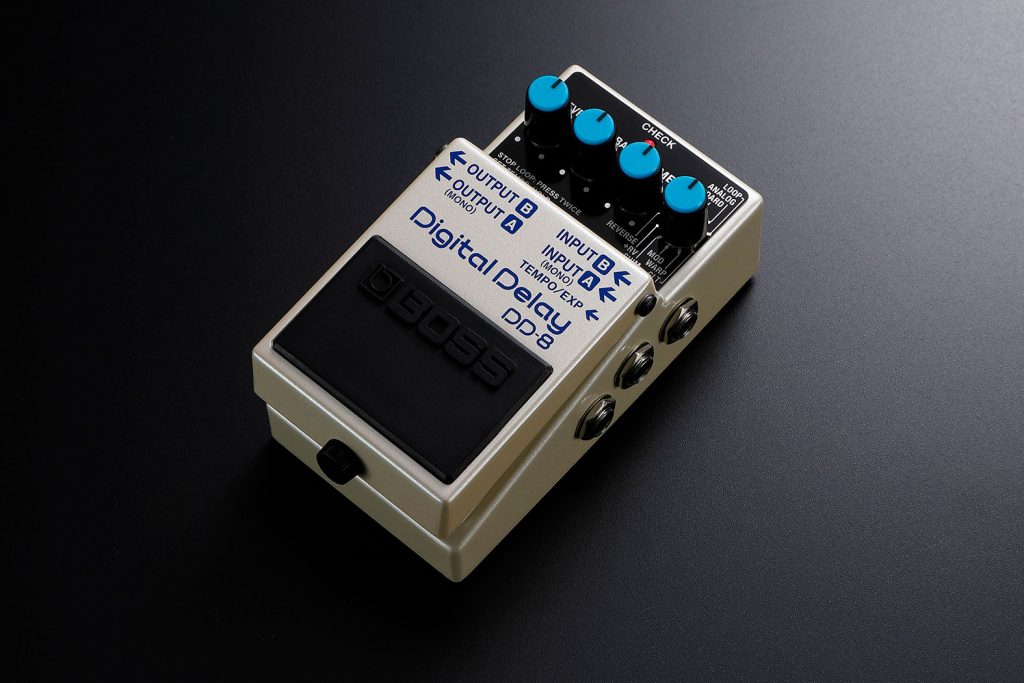
Mode
The Mode control, typically found on digital delay pedals like the DD series, allows users to switch between different delay types. The DD-8 uses the Mode setting to change between different settings quickly. On multi-function pedals like the DD-200 or DD-8, Mode allows players to switch between digital delay, analog delay, tape echo, reverse, looper, and other specialized modes.
Tap Tempo
Tap tempo allows guitarists to set the delay time to match the tempo of the music by tapping a button or footswitch. This makes it easier to sync the delay effect with the rest of the band, a drum machine, or a metronome.
"The Mode control, typically found on digital delay pedals, allows users to switch between different delay types."
Hold Function
The hold function on the DD-200 and DD-8 allows guitarists to freeze or sustain a small piece of their playing, creating a continuous loop. Players use them to create drone sounds, atmospheric textures that build in intensity, or a rhythmic backdrop to play over.
Volume and Expression
Using a volume and expression pedal with delay can open a whole world of tones. Fortunately, almost all BOSS delay pedals allow guitarists to use an expression pedal.
A volume pedal can control the overall loudness of the sound. This can be useful for fading in or fading out the delay effect on tracks or when playing live. An expression pedal controls parameters on the delay pedal, like delay time, feedback, or effect level. This allows players to adjust these on the fly and create dynamic delay sounds without changing parameters with their hands.
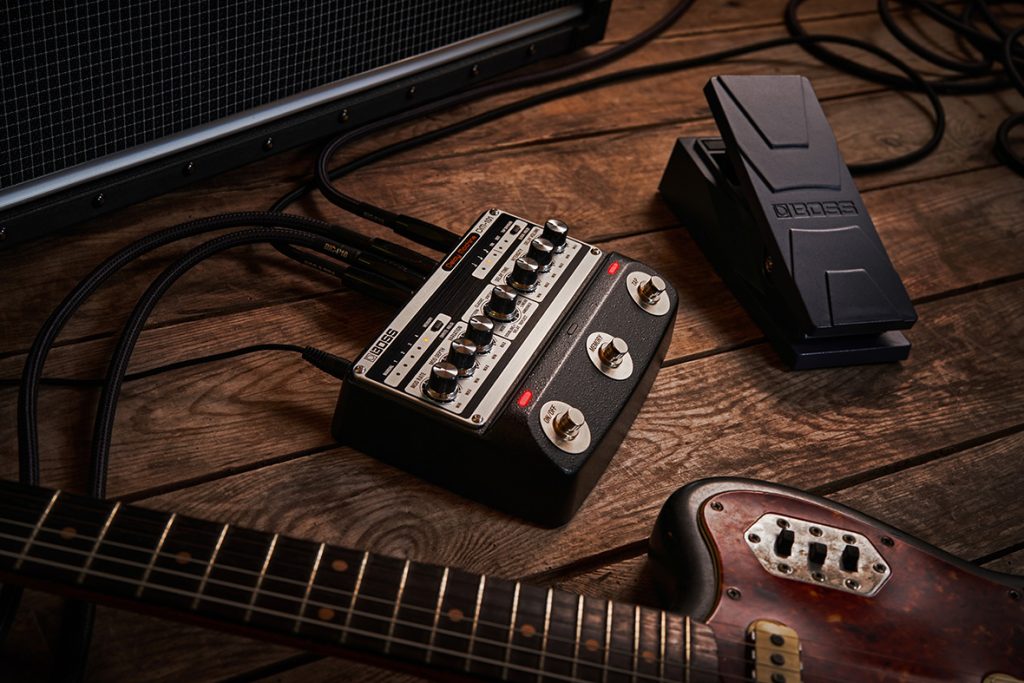
Delay Pedals and MIDI
For absolute precision, MIDI has many benefits. Using MIDI or a MIDI clock allows players to share timing between pedals. This can be vital for delays, loopers, and other time-based effects.
The DD-200 range and the DM-101 have MIDI connectivity. They feature precise control over all parameters, automating changes or syncing delay times with other MIDI-enabled equipment. In addition, these units boast memory change capability. These features are useful in a live band or studio setting where precise timing is a must.
Trails
Trails allow the echoes to continue even after the pedal is off. Rather than bypassing the pedal and the pedal cutting out, it leaves behind a sound trail that provides a natural-sounding decay. Most guitarists use it during live performances as it allows for a seamless transition between effects.
"Using MIDI or a MIDI clock allows players to share timing between pedals. This can be vital for delays, loopers, and other time-based effects."
Notable Delay Pedal Artists
Many guitarists champion delay. Eddie Van Halen used the effect on “Ain’t Talkin’ bout Love.” John Mayer uses a subtle delay on “Slow Dancing in a Burning Room” and as a percussive element in some tracks, like “Heartbreak Warfare.”
The Edge uses delay across the U2 catalog. He uses the effect to create intricate, chime-like textures. Slash used a DD-3 set to 800ms for the intro to “Welcome to The Jungle.” Brian May used delay alongside his wall of amps to get his signature sound.
David Gilmour of Pink Floyd often used long, high-feedback delay settings for his soaring lead tones, creating a vast, spacey sound. Modern players like Annie Clark (St. Vincent), Omar Rodríguez-López (Mars Volta), and Nels Cline (Wilco) also make creative use of delay. These guitarists employ the effect in unconventional ways to craft their unique sounds.
Tips and Tricks
Ambience
To create an ambient sound on a delay pedal, use a long delay time with a high level of feedback and a low mix level. This will create a wash of sound behind one’s playing rather than distinct echoes that become distracting. Think “Lucky Man” by The Verve for an idea of ambient delay. Combine this with a reverb pedal and get a seriously ethereal sound. If the pedal has one, experiment with the reverse delay setting for an otherworldly, dream-like sound that is incredibly unique to the ear.
"To create an ambient sound on a delay pedal, use a long delay time with a high level of feedback and a low mix level."
Lead Tones
Lead tones are where delay pedals shine. To enhance lead playing, use a moderate delay time (around 300-500ms) with a low to moderate feedback level (two or three repeats) and a low mix level. This will create a repeating delay effect that adds fullness and sustain to the tone without overwhelming it.
Rhythmic Effects
When creating a delayed sound for a rhythmic effect like The Edge, set the delay time at around 800 ms or more, with moderate feedback. One can create percussive sounds if the delay gets set to the song’s tempo or as a dotted eighth. Think “Where the Streets Have No Name” or the intro to “Sweet Disposition” by The Temper Trap.
Pairing Distortion with Delay
Pairing delay with distortion provides fatter, heavier riffs. The distortion will add sustain and harmonic richness to a guitar tone, while the delay will fill in the dead spots in sound between riffs. This combination is popular in rock and metal genres for lead tones. Delay is also a crucial signature sound of Tom Morello, Ghost, and others. But be careful with ordering pedals as placing delay before the distortion will result in each distorted repeats.
"Distortion will add sustain and harmonic richness to a guitar tone, while the delay will fill in the dead spots in sound between riffs."
Delay for Blues
Delay works for any genre of music. One example is using a delay pedal in a blues scenario. Blues guitarists use delay sparingly to add depth and weight to their sound, especially on solos. In addition, they sometimes use slapback delay on verse or rhythm parts. An analog or tape delay, like the DM-2W or RE-202, would be ideal. The analog sound and unpredictability or subtle nuances should be present. One will only need up to 800ms of delay for blues sounds.
To dial in the ideal setting for a blues rhythm sound, set the delay time to 20-200 ms and adjust the feedback for one or two repeats. Keep the mix level down to avoid overpowering the dry signal. Pair the BD-2 Blues Driver with delay for a winning formula.
Alternatively, to create screaming blues-style guitar solos with added weight, set the delay to 300-800. The sound will resemble Prince’s “I Could Never Take the Place of Your Man” or Jimi Hendrix at Woodstock.
Delay with Other Instruments
While delay is most associated with the guitar, it works with any instrument to add depth and extra flavor. Whether it’s a synthesizer, a drum machine, or a vocal track, a delay pedal can provide a new dynamic. Delay pedals are one of the most valuable pedals for any musician.
"While delay is most associated with the guitar, it works with any instrument to add depth and extra flavor."
Choosing a BOSS Delay Pedal
One must find the right BOSS delay pedal to suit their needs. Looking for a subtle delay with the ability to add some extra repeats? Need absolute clarity with a digital delay with MIDI functionality. Want the unpredictable nature of a tape echo? Or all of them rolled into one handy guitar delay pedal like the DD-200? Try several delays to find the perfect pedal.
